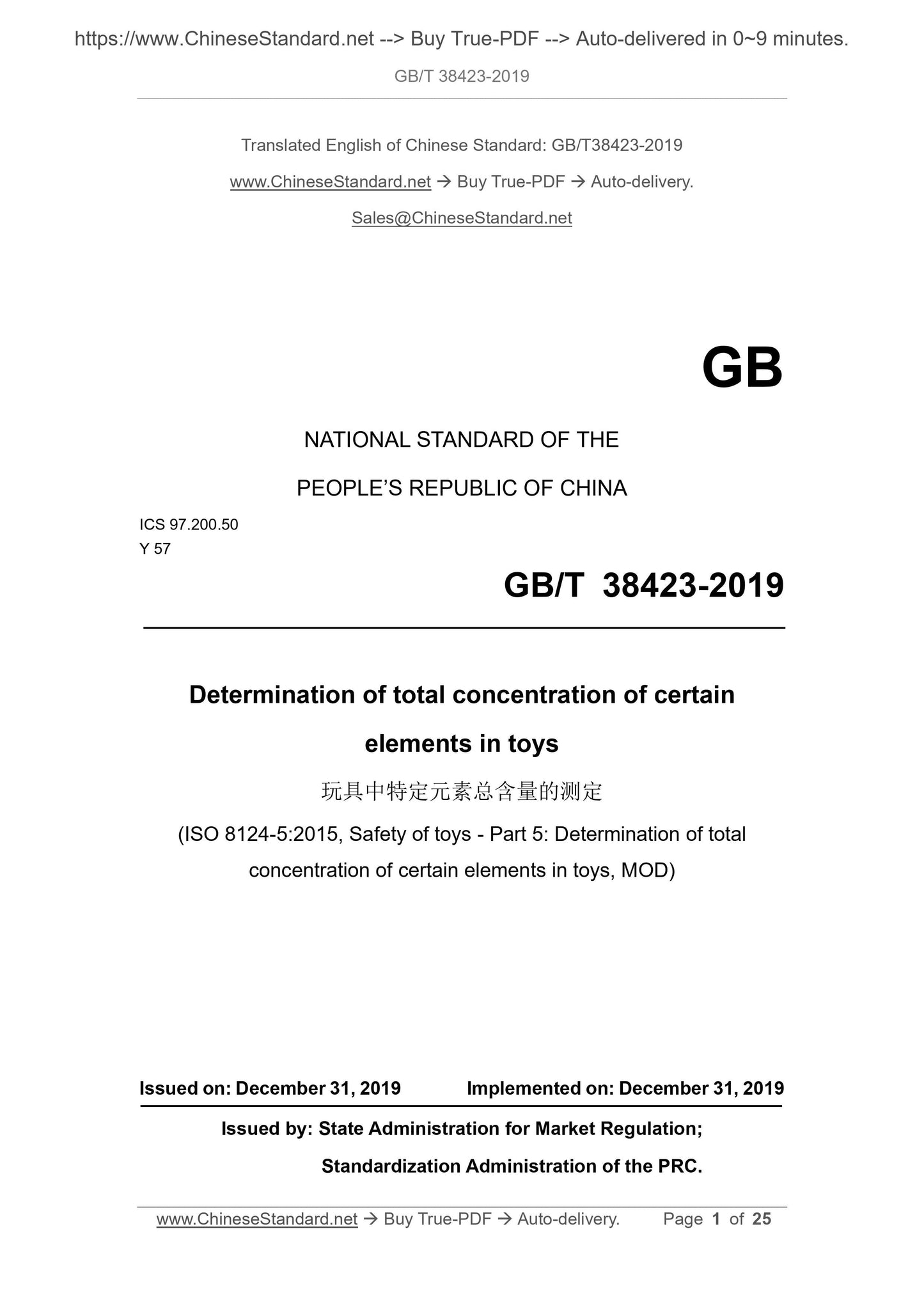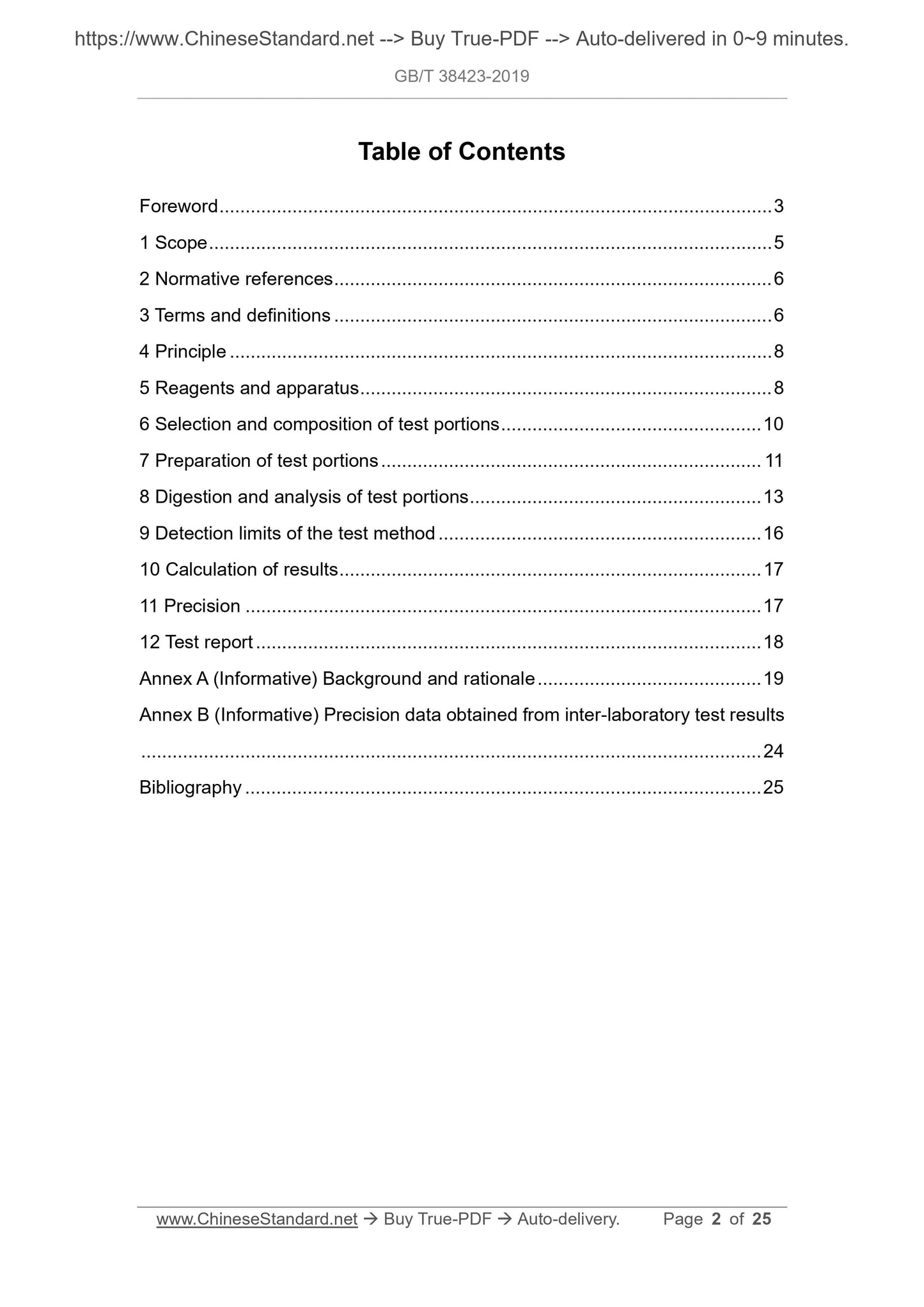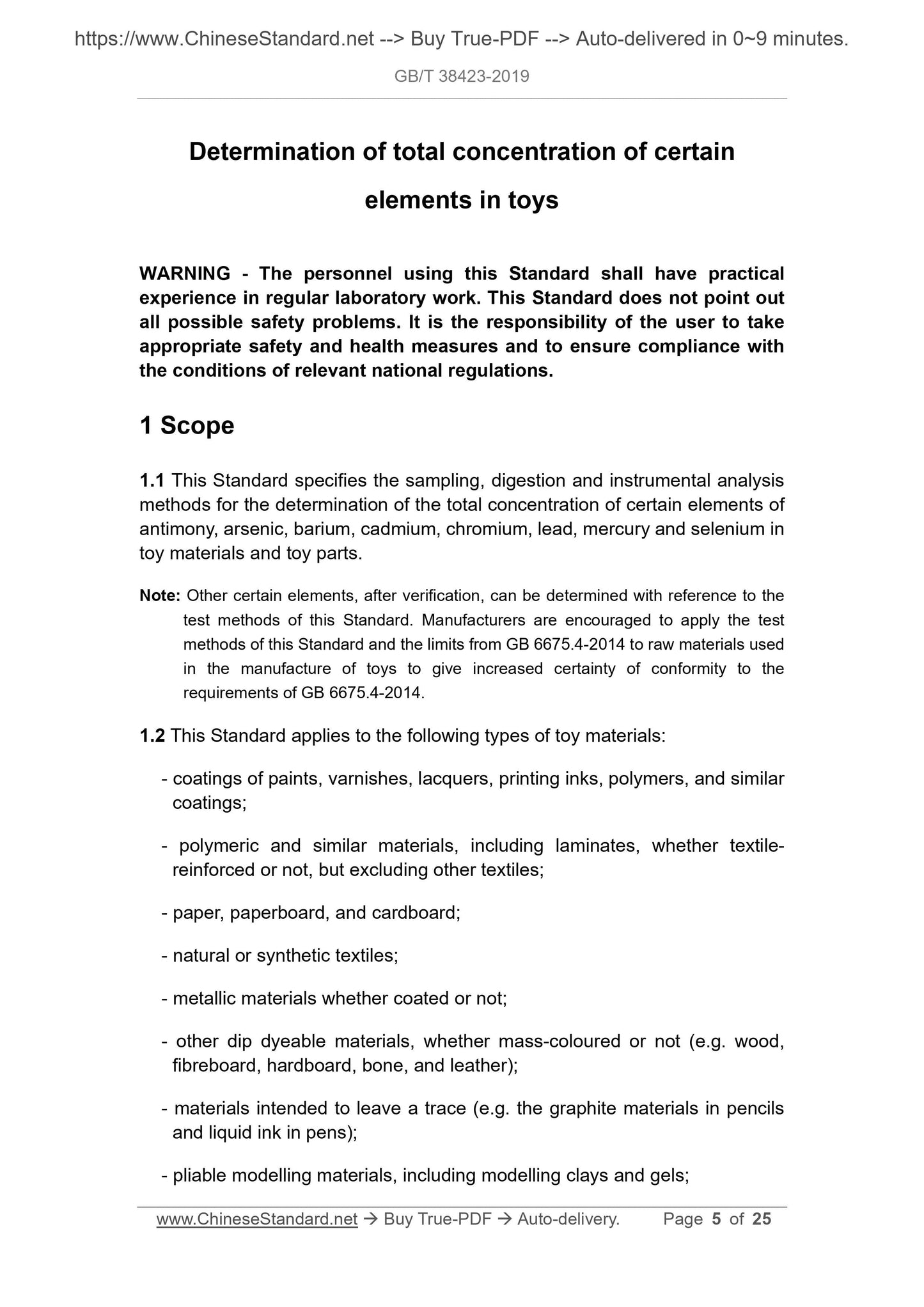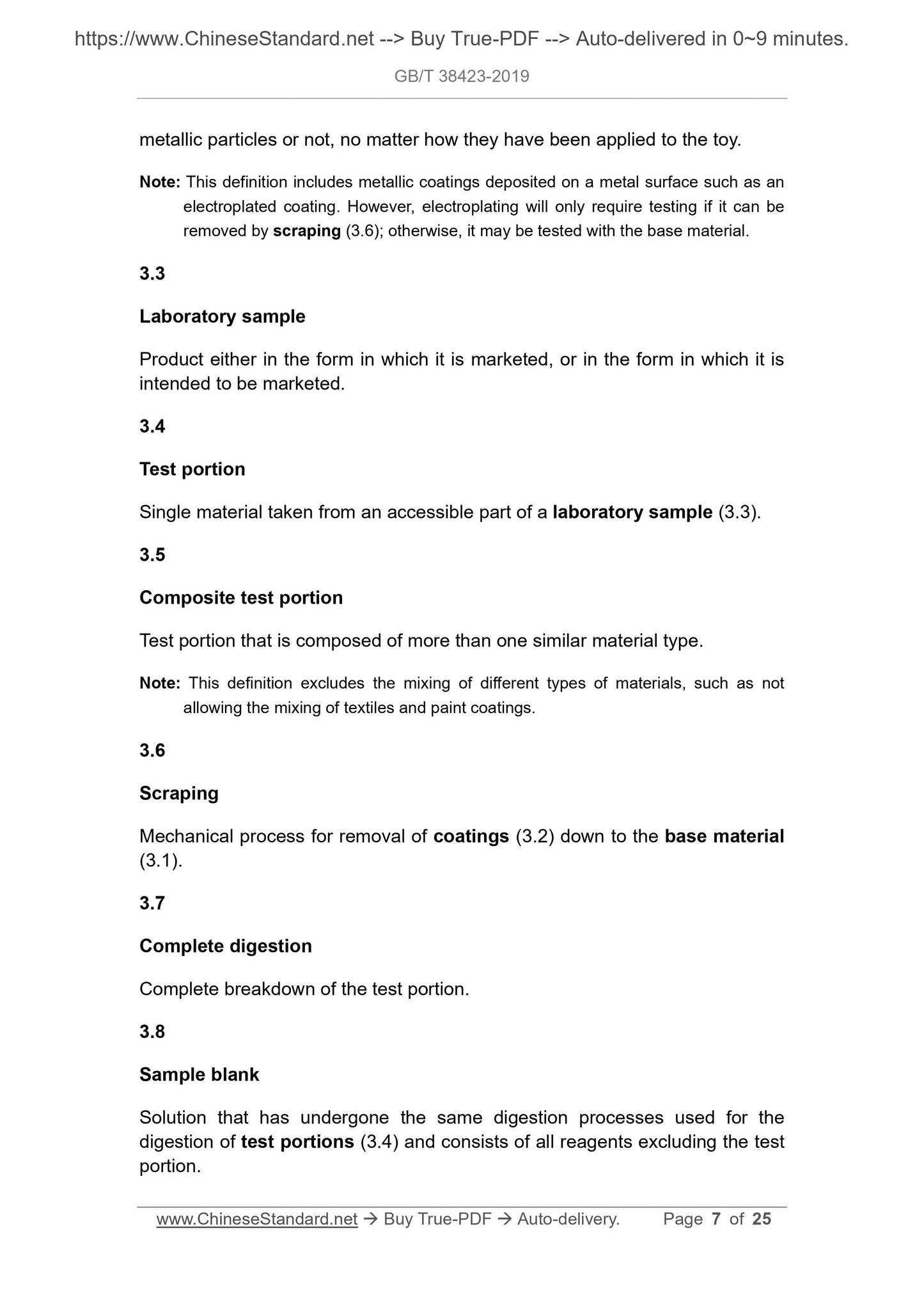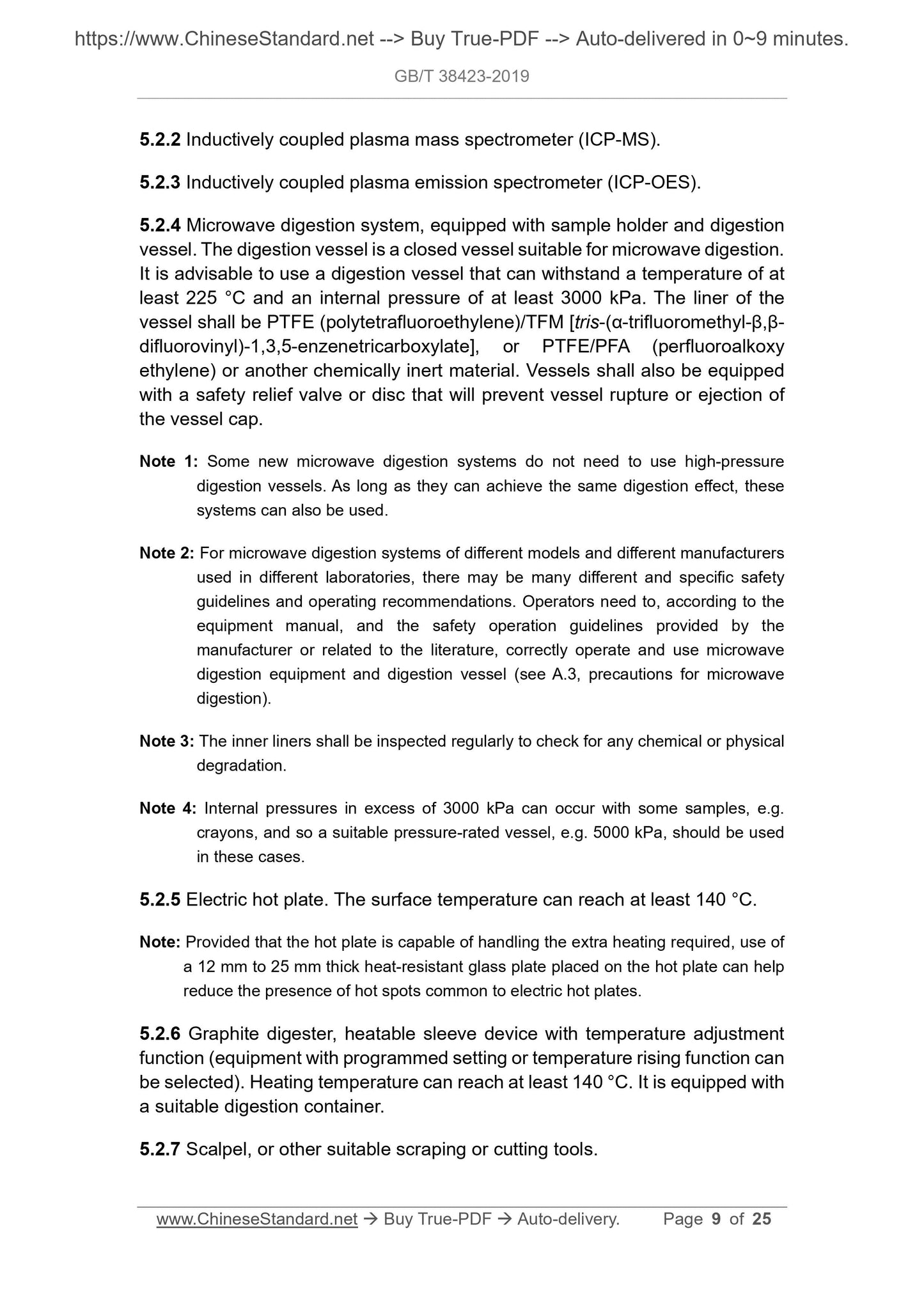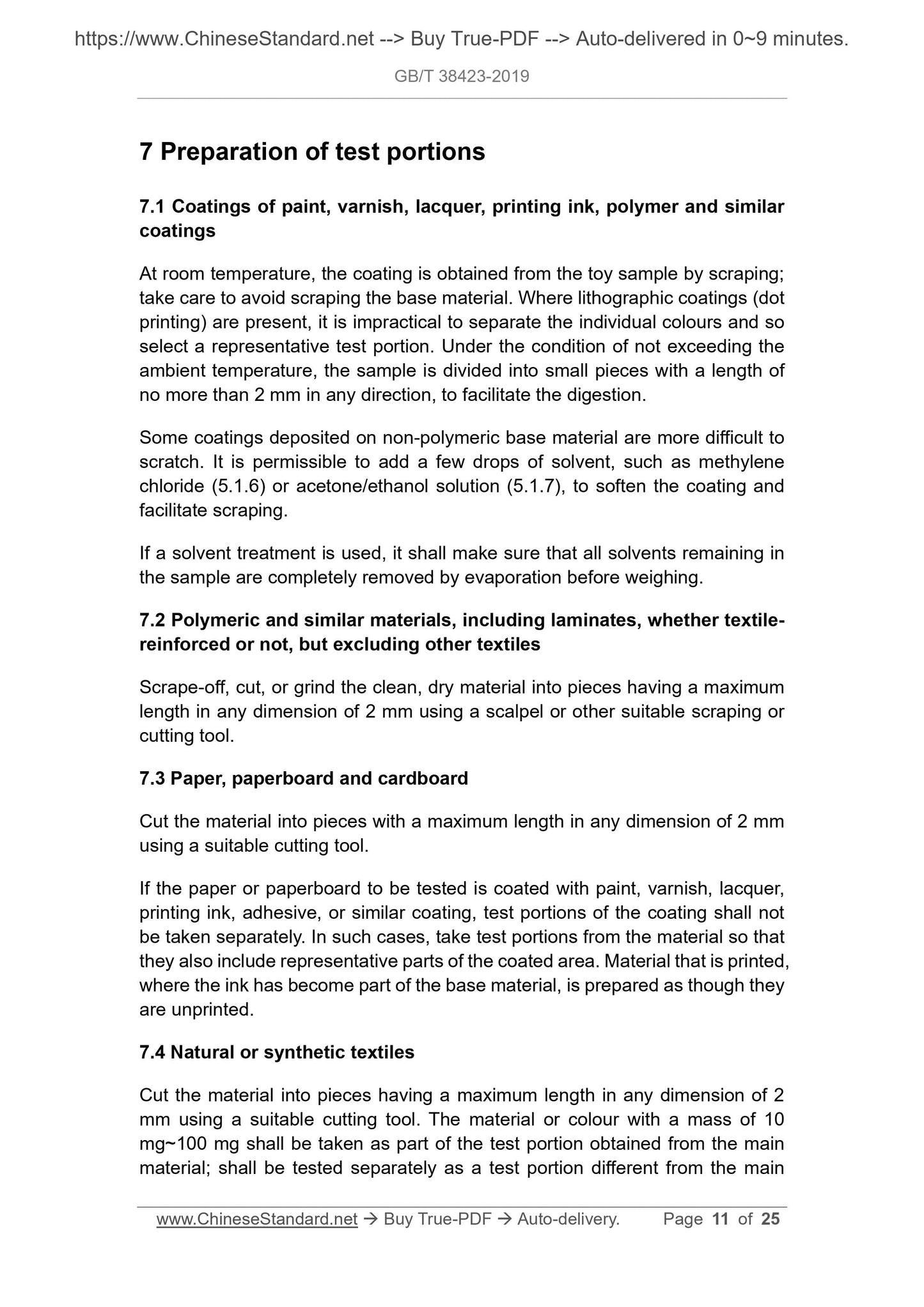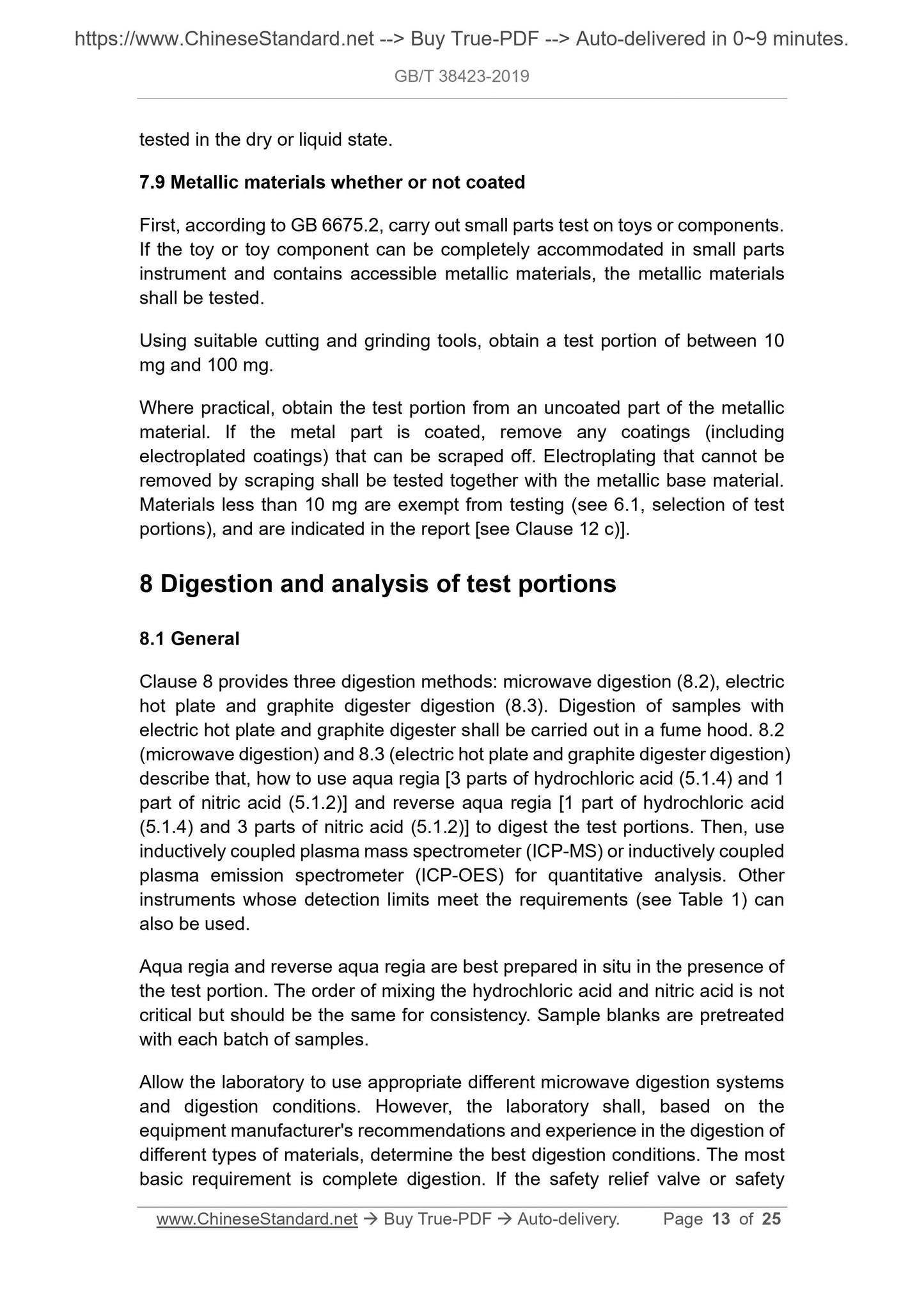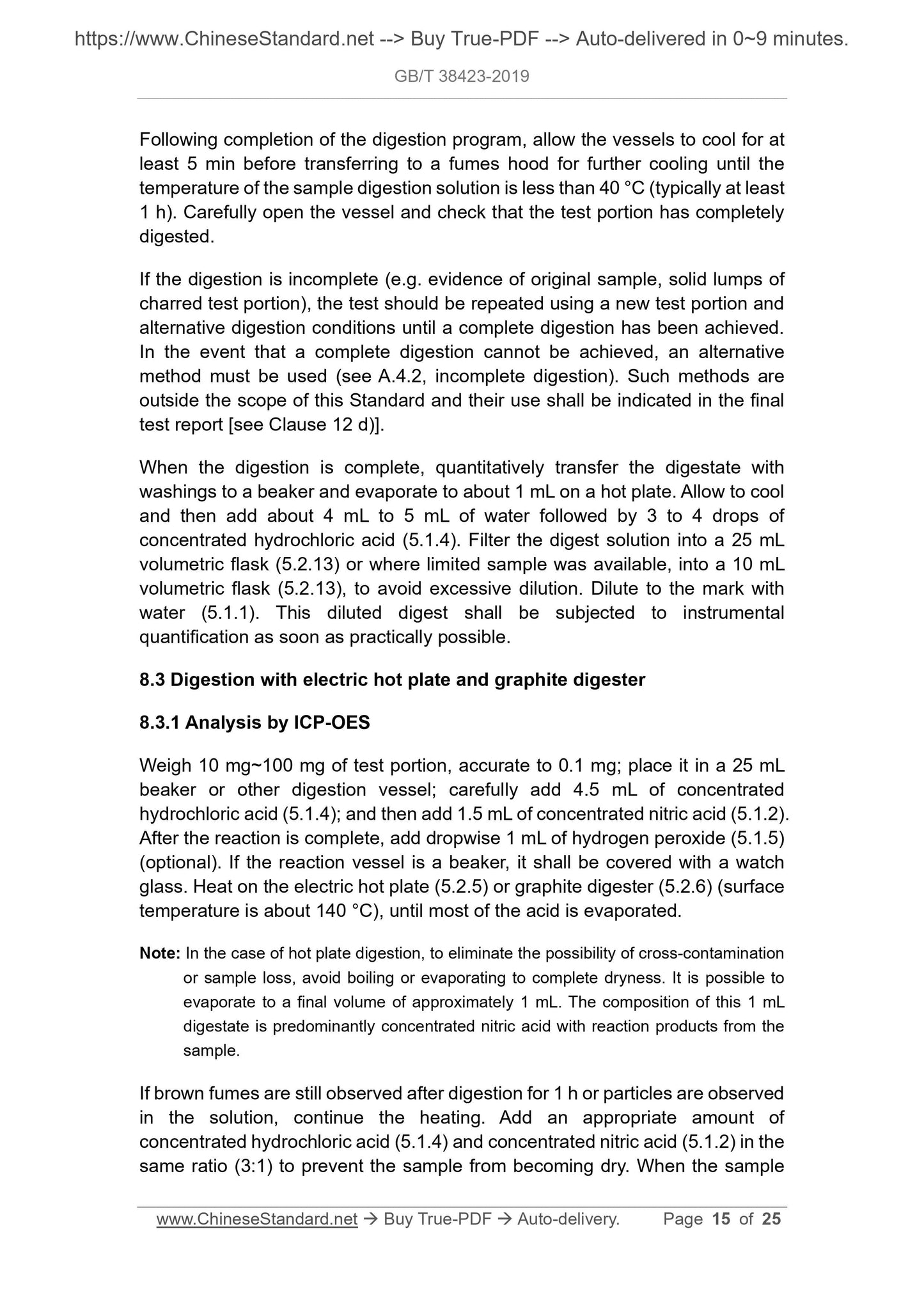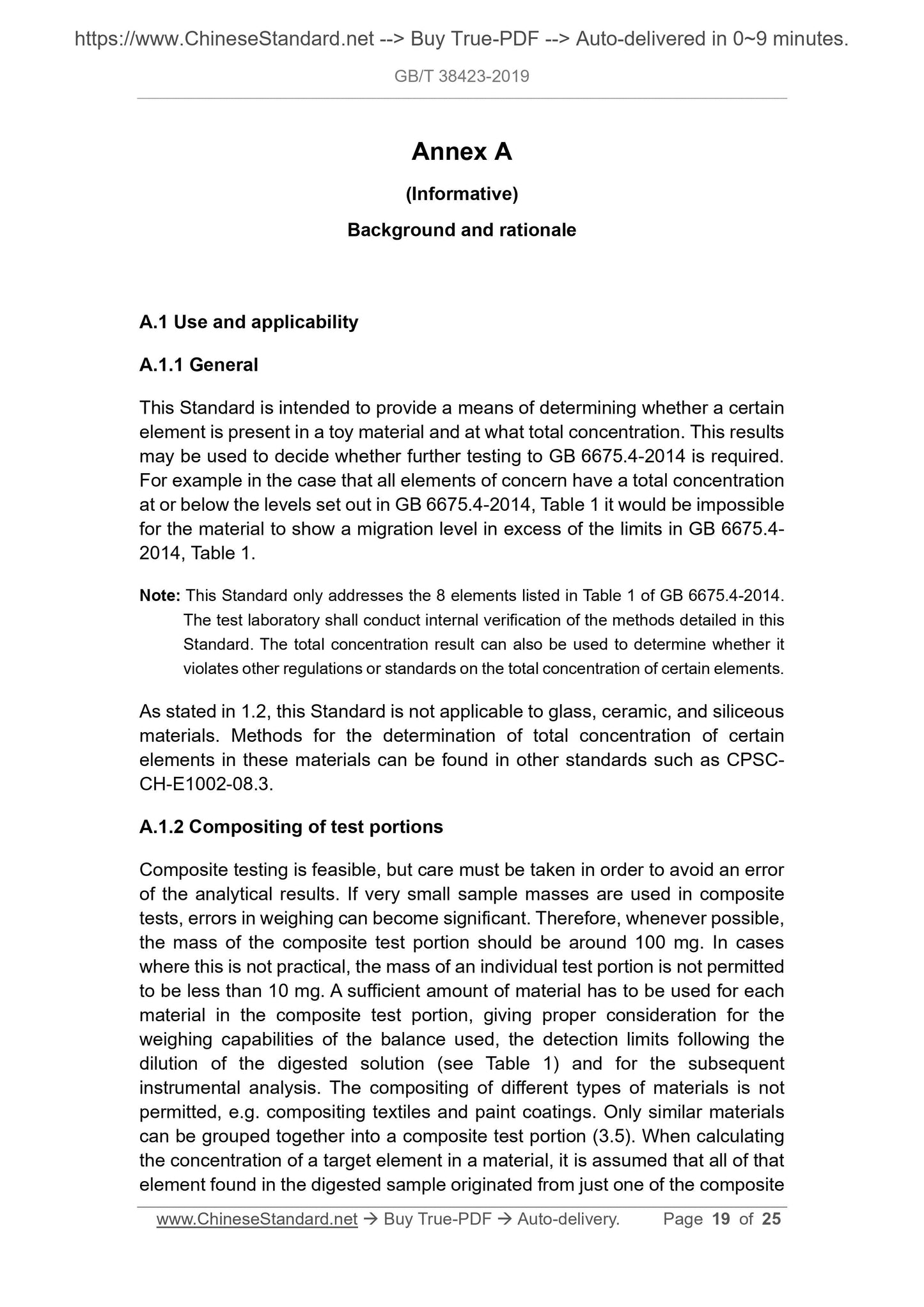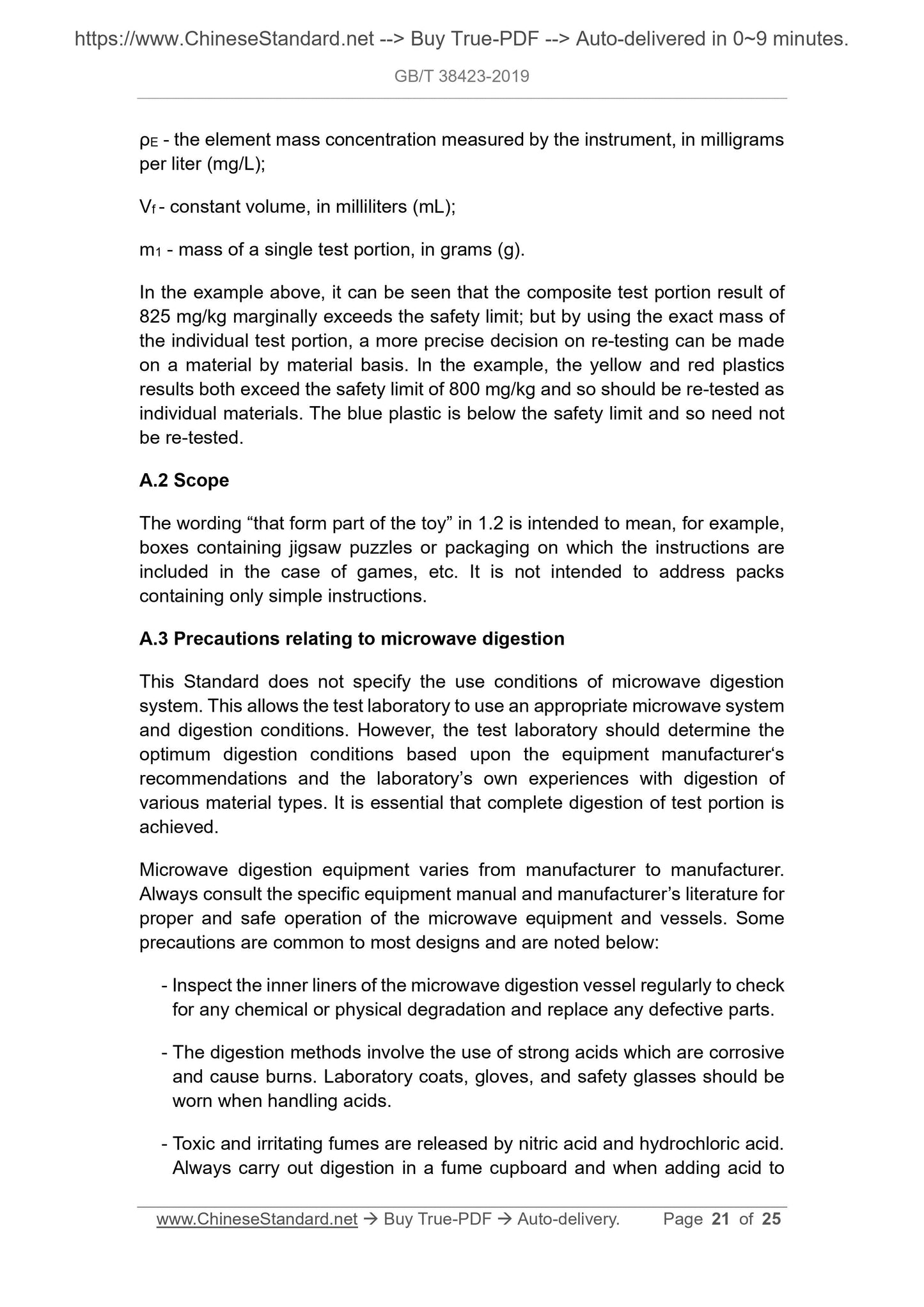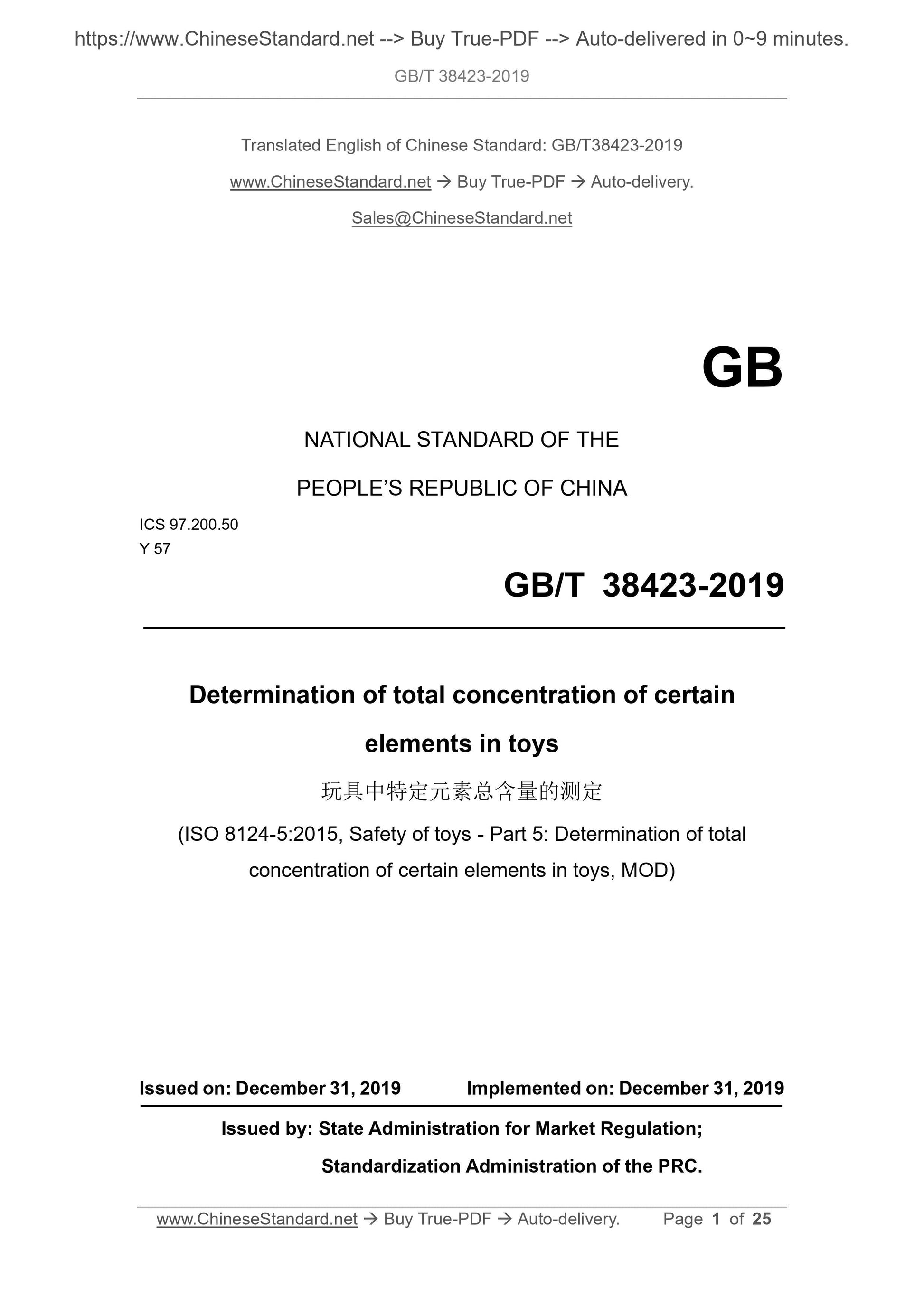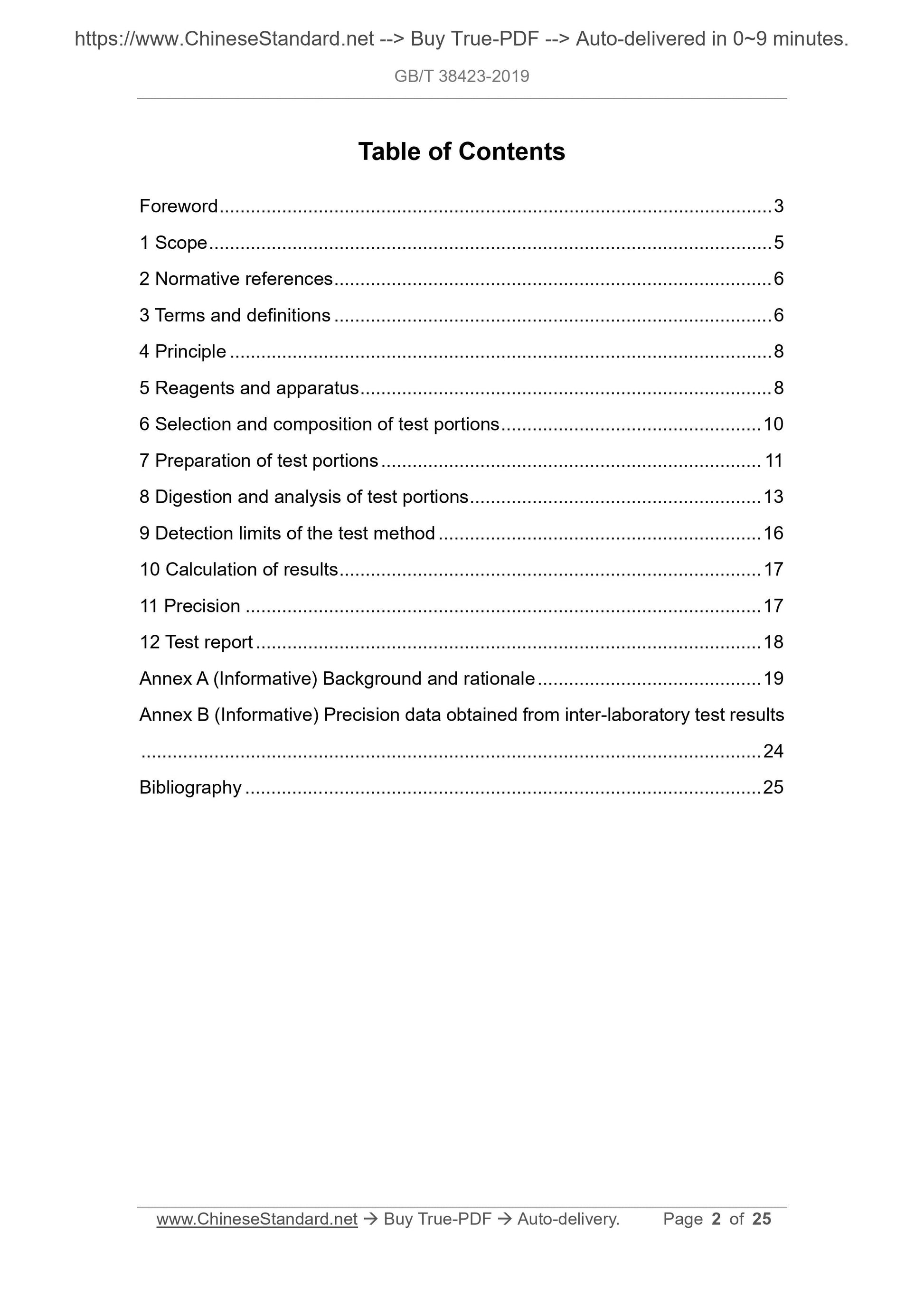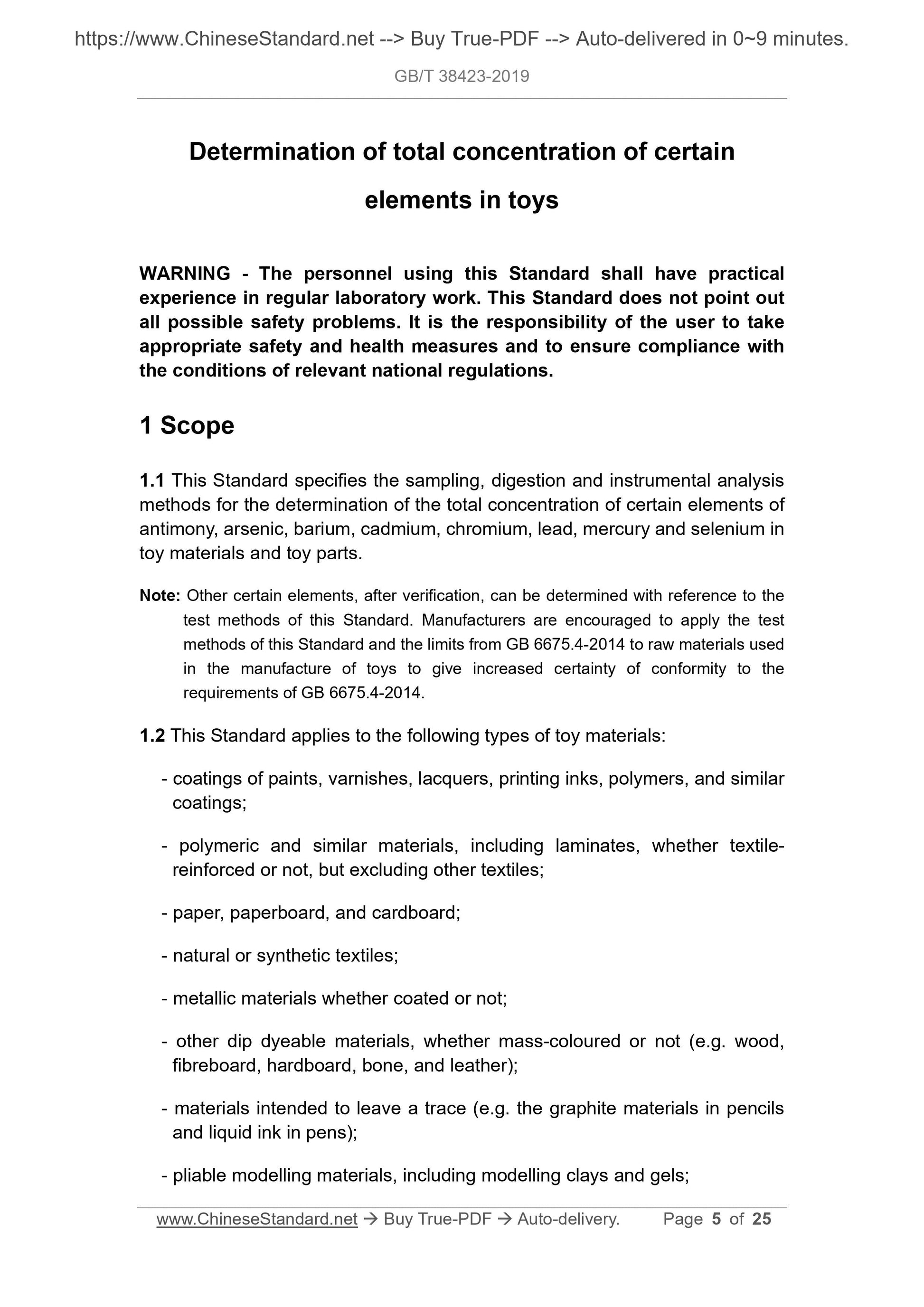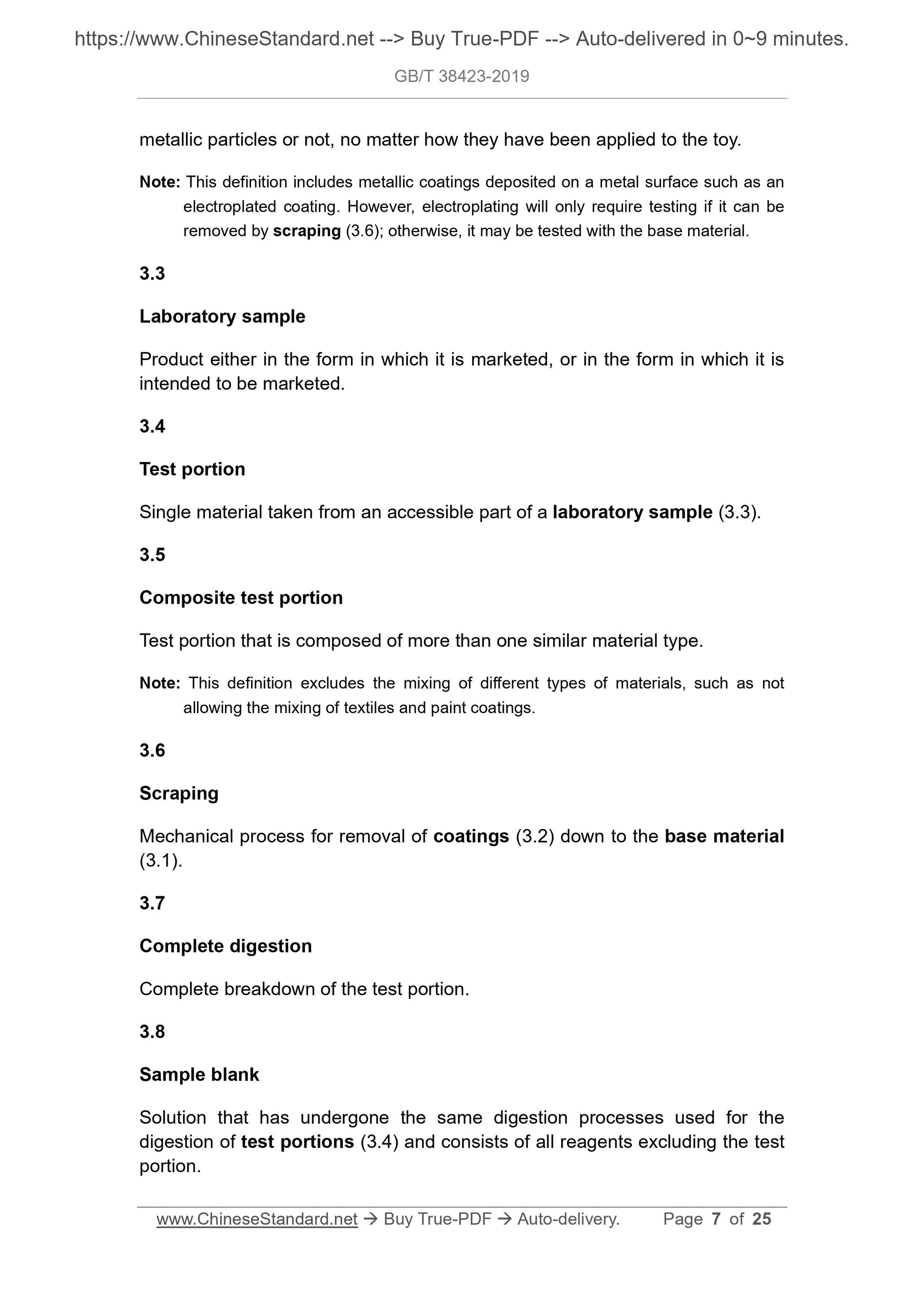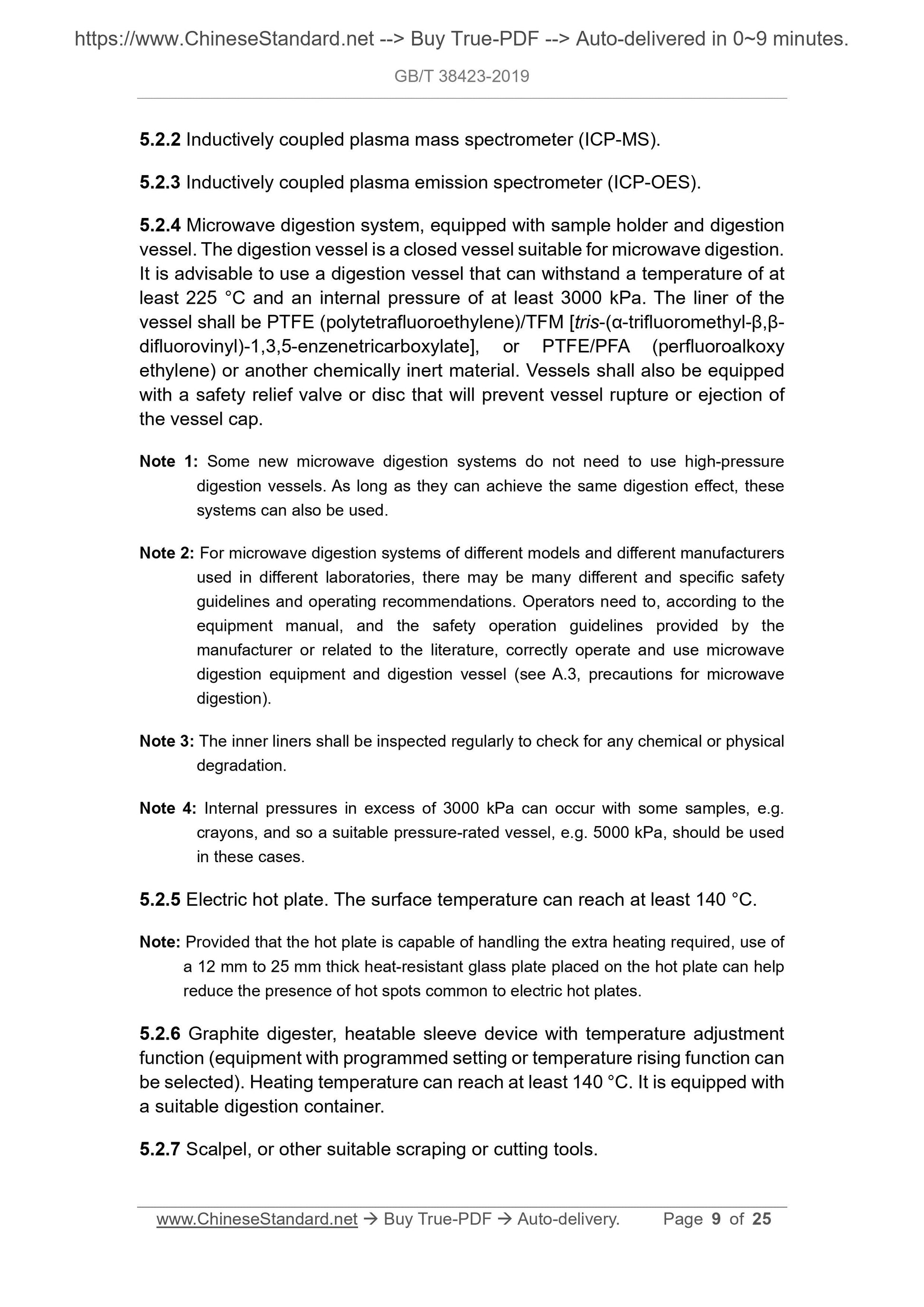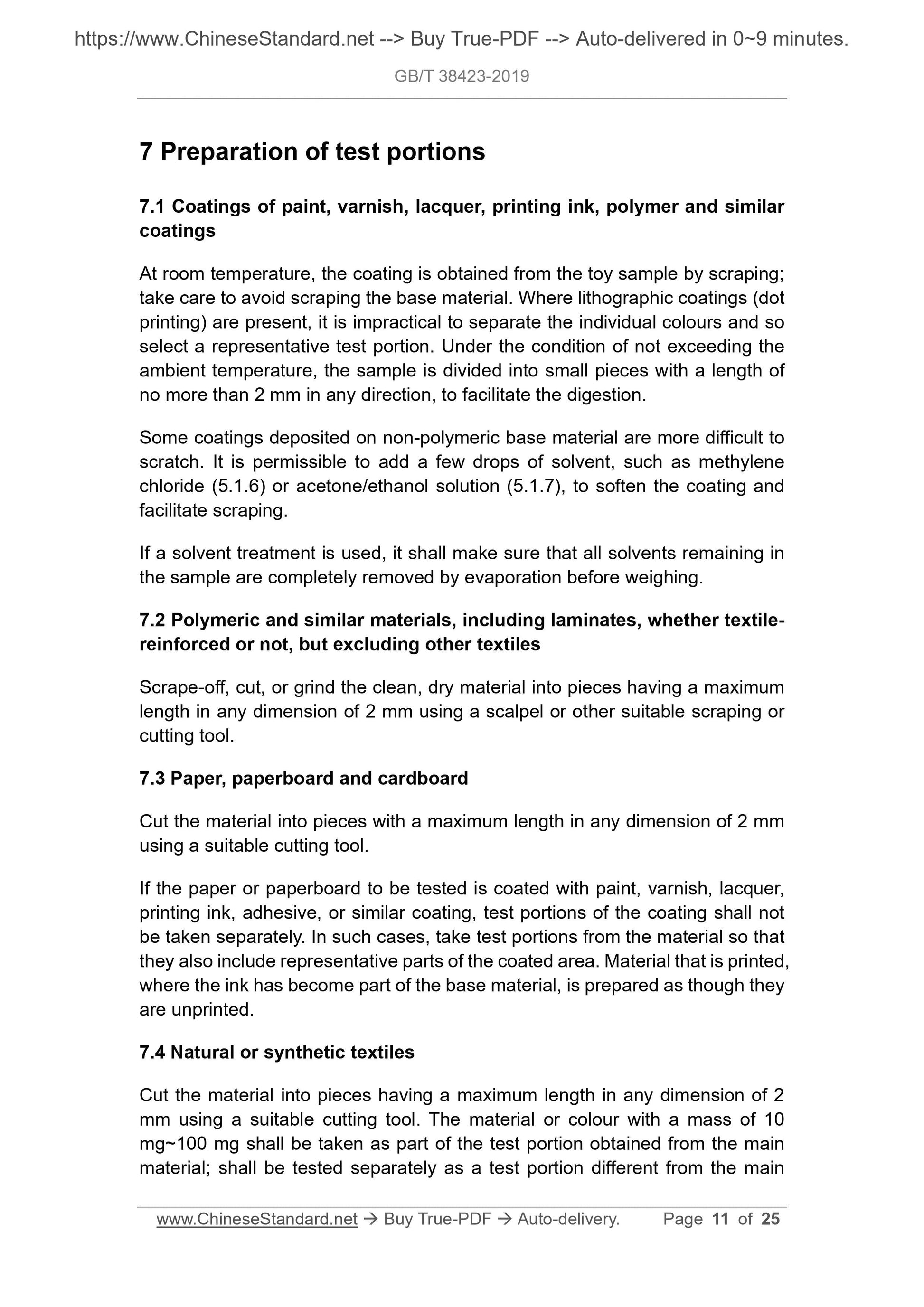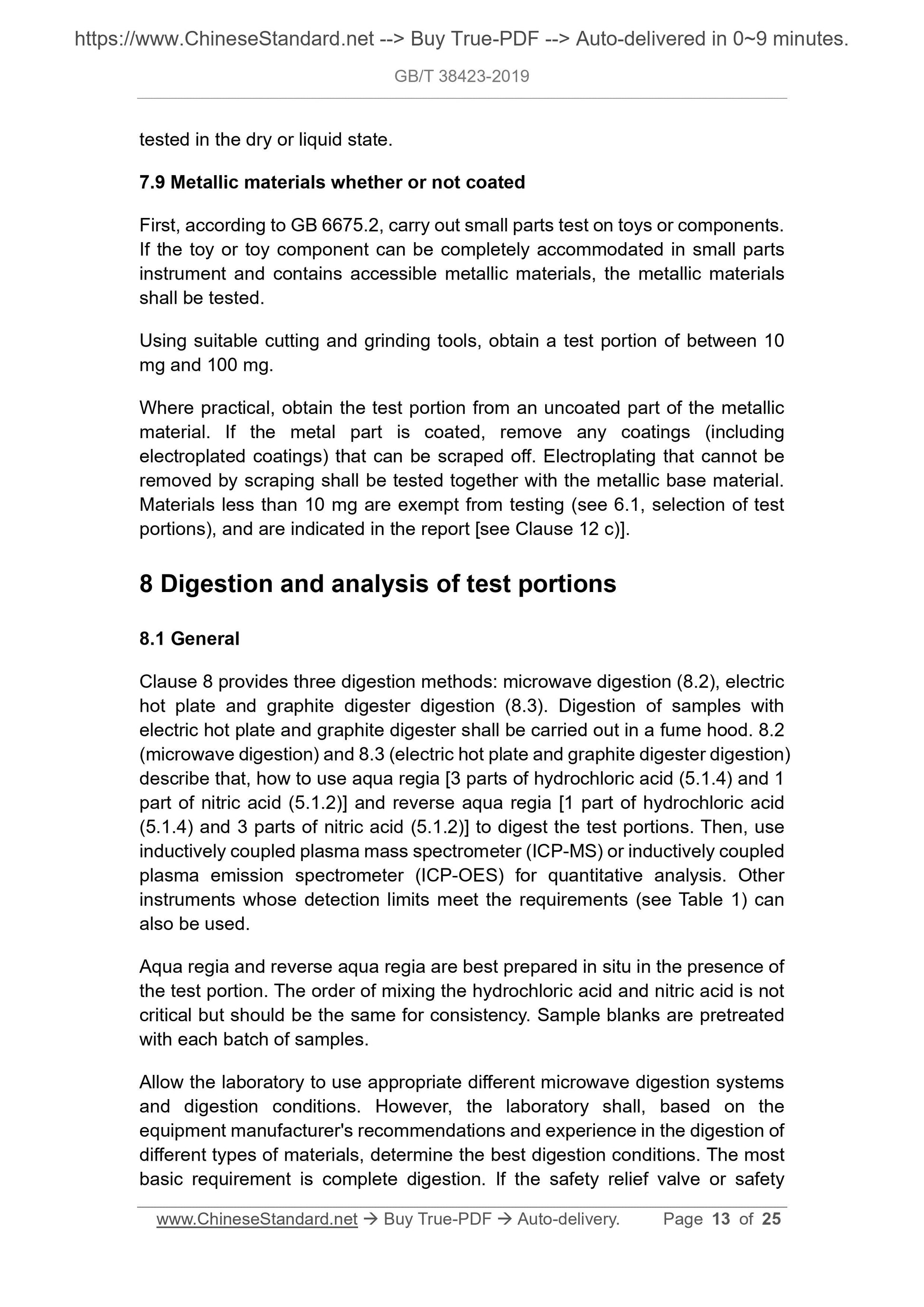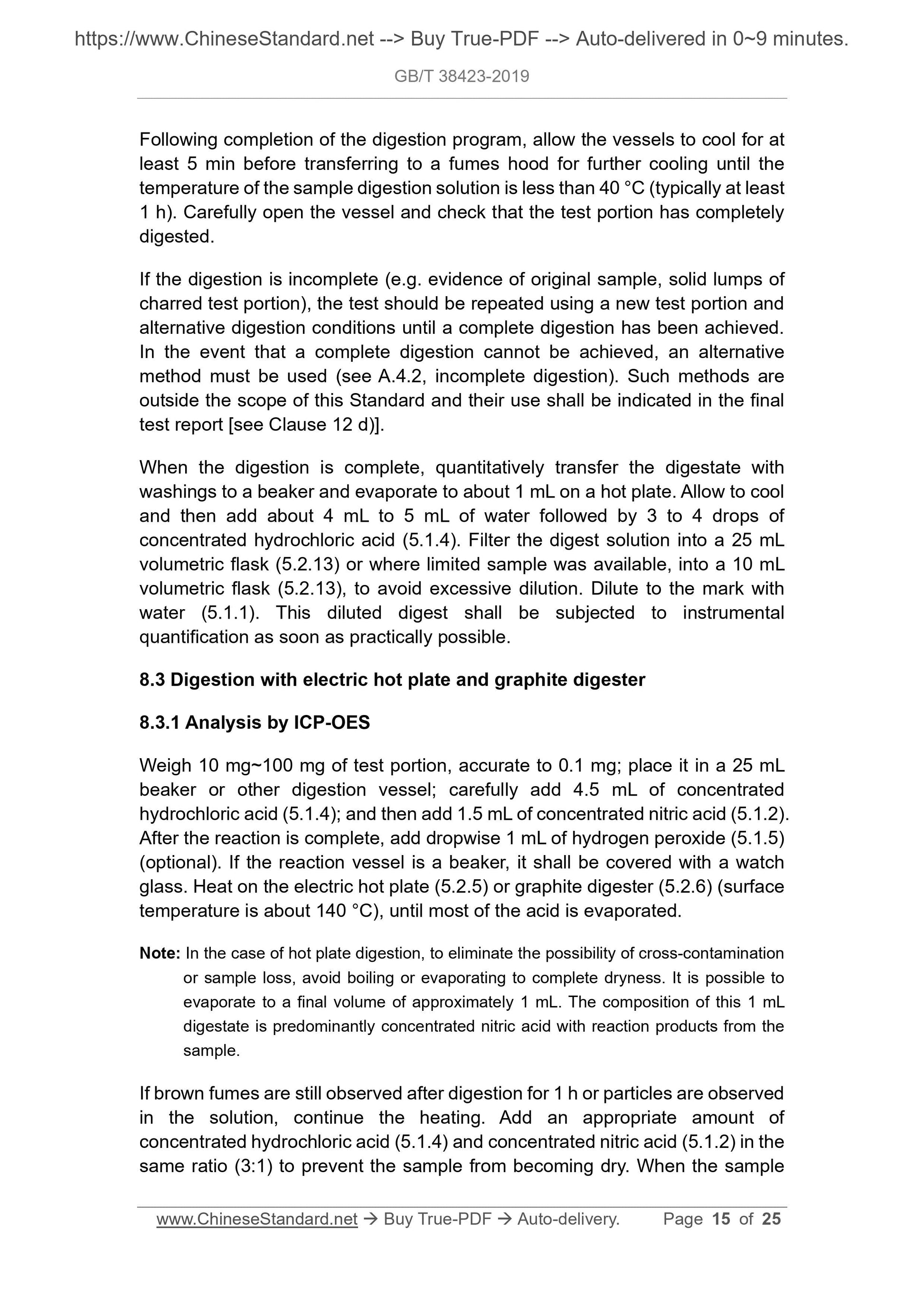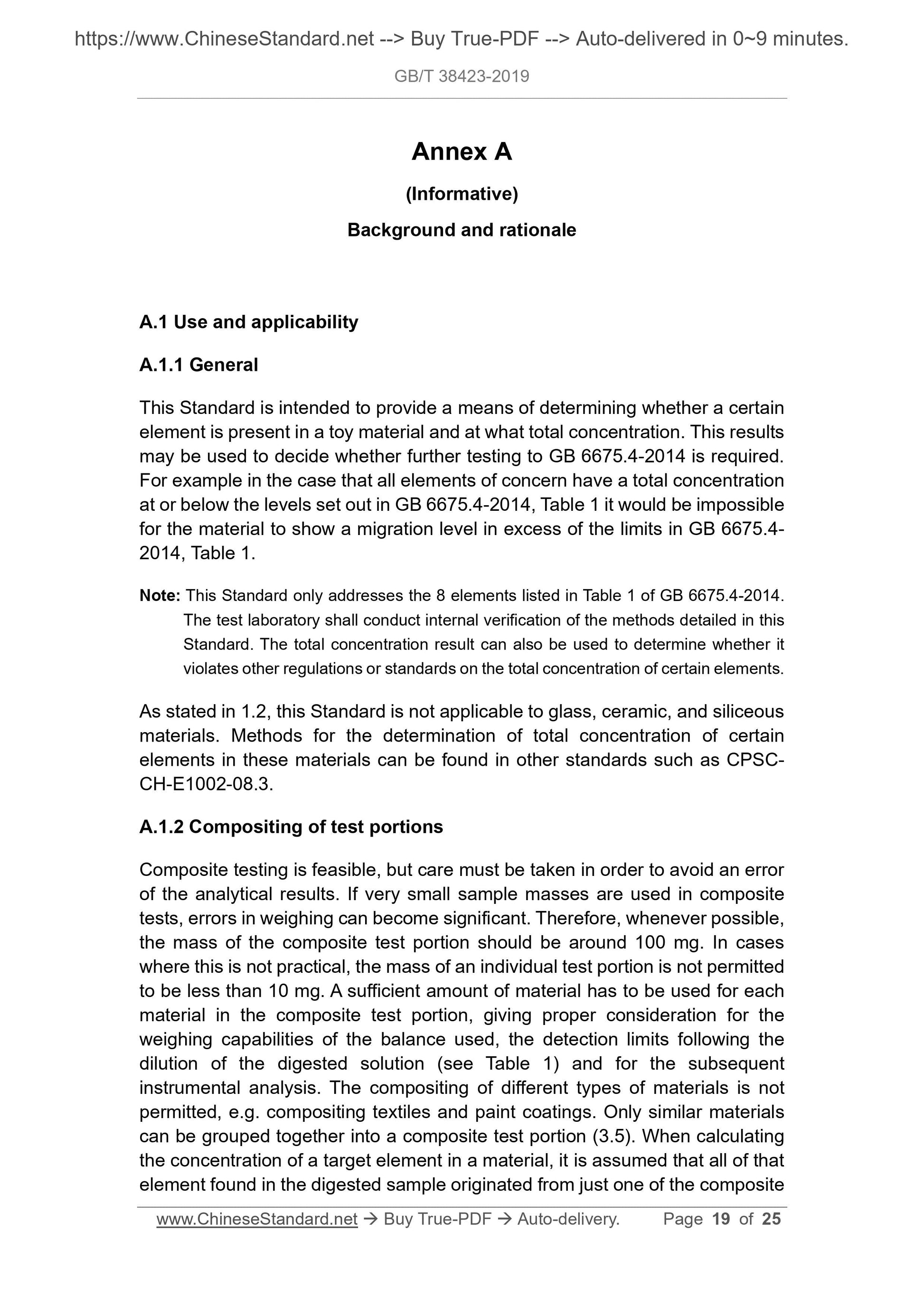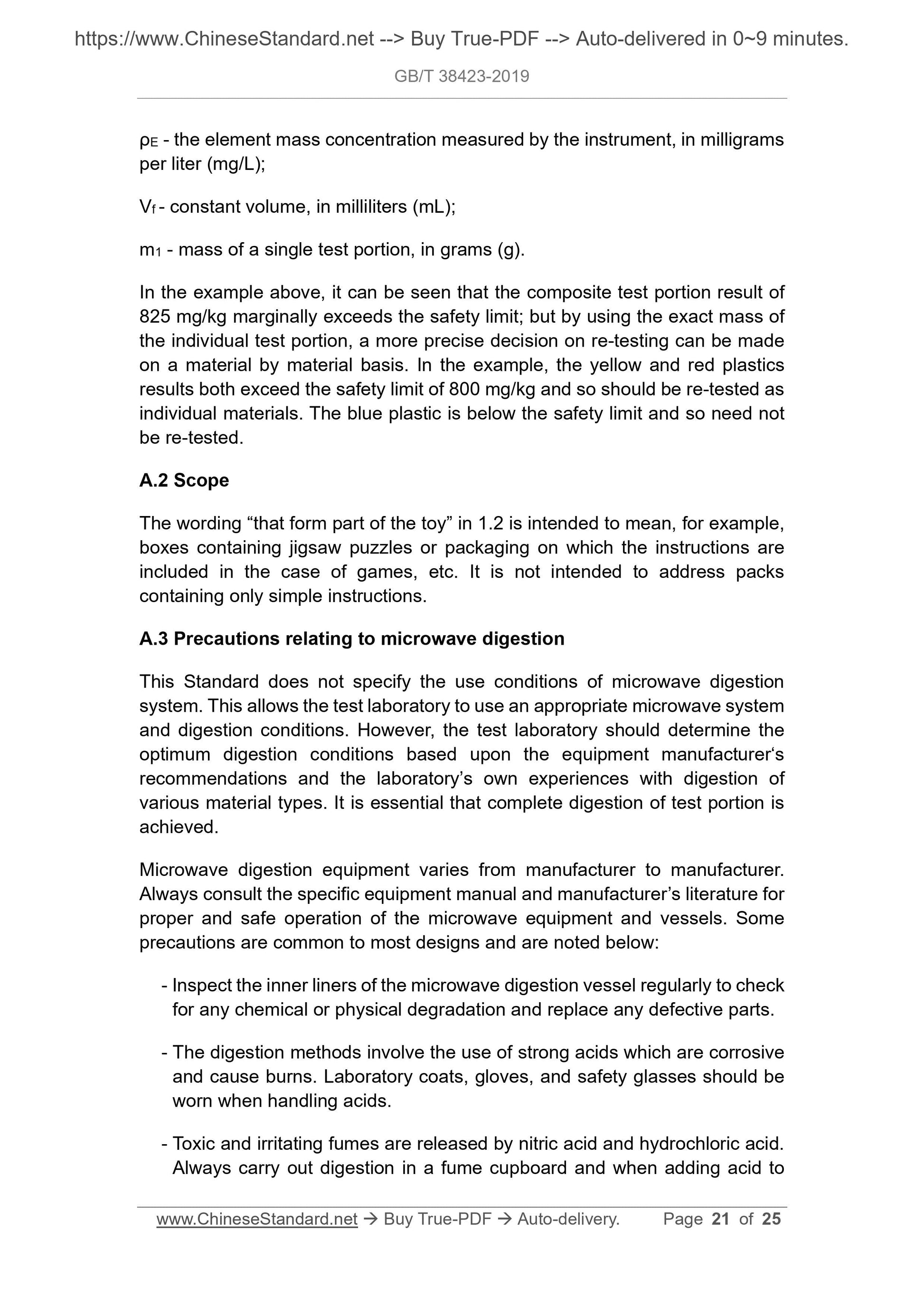1
/
of
10
www.ChineseStandard.us -- Field Test Asia Pte. Ltd.
GB/T 38423-2019 English PDF (GB/T38423-2019)
GB/T 38423-2019 English PDF (GB/T38423-2019)
Regular price
$225.00
Regular price
Sale price
$225.00
Unit price
/
per
Shipping calculated at checkout.
Couldn't load pickup availability
GB/T 38423-2019: Determination of total concentration of certain elements in toys
Delivery: 9 seconds. Download (and Email) true-PDF + Invoice.Get Quotation: Click GB/T 38423-2019 (Self-service in 1-minute)
Newer / historical versions: GB/T 38423-2019
Preview True-PDF
Scope
1.1 This Standard specifies the sampling, digestion and instrumental analysismethods for the determination of the total concentration of certain elements of
antimony, arsenic, barium, cadmium, chromium, lead, mercury and selenium in
toy materials and toy parts.
Note: Other certain elements, after verification, can be determined with reference to the
test methods of this Standard. Manufacturers are encouraged to apply the test
methods of this Standard and the limits from GB 6675.4-2014 to raw materials used
in the manufacture of toys to give increased certainty of conformity to the
requirements of GB 6675.4-2014.
1.2 This Standard applies to the following types of toy materials:
- coatings of paints, varnishes, lacquers, printing inks, polymers, and similar
coatings;
- polymeric and similar materials, including laminates, whether textile-
reinforced or not, but excluding other textiles;
- paper, paperboard, and cardboard;
- natural or synthetic textiles;
- metallic materials whether coated or not;
- other dip dyeable materials, whether mass-coloured or not (e.g. wood,
fibreboard, hardboard, bone, and leather);
- materials intended to leave a trace (e.g. the graphite materials in pencils
and liquid ink in pens);
- pliable modelling materials, including modelling clays and gels;
metallic particles or not, no matter how they have been applied to the toy.
Note: This definition includes metallic coatings deposited on a metal surface such as an
electroplated coating. However, electroplating will only require testing if it can be
removed by scraping (3.6); otherwise, it may be tested with the base material.
3.3
Laboratory sample
Product either in the form in which it is marketed, or in the form in which it is
intended to be marketed.
3.4
Test portion
Single material taken from an accessible part of a laboratory sample (3.3).
3.5
Composite test portion
Test portion that is composed of more than one similar material type.
Note: This definition excludes the mixing of different types of materials, such as not
allowing the mixing of textiles and paint coatings.
3.6
Scraping
Mechanical process for removal of coatings (3.2) down to the base material
(3.1).
3.7
Complete digestion
Complete breakdown of the test portion.
3.8
Sample blank
Solution that has undergone the same digestion processes used for the
digestion of test portions (3.4) and consists of all reagents excluding the test
portion.
5.2.2 Inductively coupled plasma mass spectrometer (ICP-MS).
5.2.3 Inductively coupled plasma emission spectrometer (ICP-OES).
5.2.4 Microwave digestion system, equipped with sample holder and digestion
vessel. The digestion vessel is a closed vessel suitable for microwave digestion.
It is advisable to use a digestion vessel that can withstand a temperature of at
least 225 °C and an internal pressure of at least 3000 kPa. The liner of the
vessel shall be PTFE (polytetrafluoroethylene)/TFM [tris-(α-trifluoromethyl-β,β-
difluorovinyl)-1,3,5-enzenetricarboxylate], or PTFE/PFA (perfluoroalkoxy
ethylene) or another chemically inert material. Vessels shall also be equipped
with a safety relief valve or disc that will prevent vessel rupture or ejection of
the vessel cap.
Note 1: Some new microwave digestion systems do not need to use high-pressure
digestion vessels. As long as they can achieve the same digestion effect, these
systems can also be used.
Note 2: For microwave digestion systems of different models and different manufacturers
used in different laboratories, there may be many different and specific safety
guidelines and operating recommendations. Operators need to, according to the
equipment manual, and the safety operation guidelines provided by the
manufacturer or related to the literature, correctly operate and use microwave
digestion equipment and digestion vessel (see A.3, precautions for microwave
digestion).
Note 3: The inner liners shall be inspected regularly to check for any chemical or physical
degradation.
Note 4: Internal pressures in excess of 3000 kPa can occur with some samples, e.g.
crayons, and so a suitable pressure-rated vessel, e.g. 5000 kPa, should be used
in these cases.
5.2.5 Electric hot plate. The surface temperature can reach at least 140 °C.
Note: Provided that the hot plate is capable of handling the extra heating required, use of
a 12 mm to 25 mm thick heat-resistant glass plate placed on the hot plate can help
reduce the presence of hot spots common to electric hot plates.
5.2.6 Graphite digester, heatable sleeve device with temperature adjustment
function (equipment with programmed setting or temperature rising function can
be selected). Heating temperature can reach at least 140 °C. It is equipped with
a suitable digestion container.
5.2.7 Scalpel, or other suitable scraping or cutting tools.
Basic Data
| Standard ID | GB/T 38423-2019 (GB/T38423-2019) |
| Description (Translated English) | Determination of total concentration of certain elements in toys |
| Sector / Industry | National Standard (Recommended) |
| Classification of Chinese Standard | Y57 |
| Classification of International Standard | 97.200.50 |
| Word Count Estimation | 18,129 |
| Date of Issue | 2019-12-31 |
| Date of Implementation | 2019-12-31 |
| Issuing agency(ies) | State Administration for Market Regulation, China National Standardization Administration |
Share
